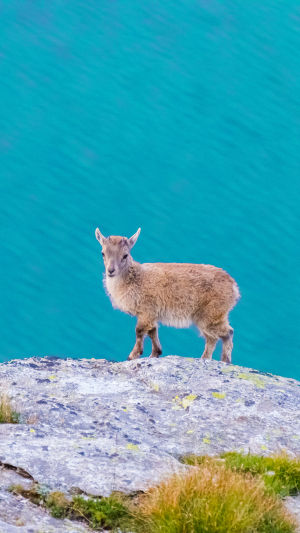In foreign countries, there is an age-old dam with a slope close to 90 degrees, almost perpendicular to the ground. It is about 160 feet high, and humans are deterred by its height.
However, in this place where people's feet tremble, there are many dense black spots that resemble human shadows. From a distance, it seems like someone is climbing above the dam. Upon closer inspection, these black spots are not human bodies at all, but a group of sheep.
This group of sheep is lively and jumping on the dam, which makes people sweat for them. In fact, their identity is not simple! They are the "parkour" animals of the animal world, also known as "rock wall elves" or "rock climbers". They are the rocking sheep.
Rock sheep may be unfamiliar to many people. As their name suggests, they live in rock-related environments and are the world's most skilled climbing sheep. However, they often lose their footing and fall from very high rock walls. Additionally, they face threats from natural predators and poachers, resulting in a limited population.
Rock sheep are also known as cliff sheep and rock goats because they always live with sheer cliffs. They have common features of both sheep and goats, including a pair of large horns like goats. The difference is that the horns do not hover. Since they have to live on cliffs for a long time, their horns are about the same size as sheep.
They do not have too much fur, only a part of their hair is simple enough to protect against the cold. If they had as much fur as sheep, it would be challenging for them to move around.
As unique rock sheep on the Tibetan Plateau in China, they are naturally resistant to cold and live in the mountains with altitudes ranging from 2100-6300 meters.
While the Tibetan plateau is vast, some rock sheep are distributed in various areas that are suitable for their survival. However, their habitat has one thing in common – they all live on top of steep cliffs. It is rare to see traces of rock sheep in the sparse forests and bushes of the plateau.
The rocking sheep that have lived among rocks for a long time also have fur that resembles the color of rocks. When they rest on the grass, they can blend in with the rocks better and avoid being detected by natural predators. Although the rock climbing skills of rock sheep are not always on display, they spend most of their time on flatlands.
When threatened by predators, they will quickly stand up and jump onto rocks to avoid danger. They also search for salt on steep walls, which is crucial for their survival.
Rock sheep, who feed on grass and trees all year round, often lack salt due to environmental issues. As rocks and dirt do not contain salt, the rain and wind on the cliffs provide sufficient exposure to the sun, leaving behind a lot of salt.
While rock sheep climb to save their lives, it can also be fatal for them. When they flee up the steep cliff, they tend to look back to see if the threat still exists. However, this action can often be their downfall, as they lose their balance and fall headlong from the cliff.
While the rock sheep has developed the ability to fall from a normal height to protect its whole body, it is helpless when it comes to withstanding the high and steep cliffs and debris below the mountain. As a result, looking back often leads to their death.





